Ninkeo Kart was my first attempt at making a proper 3D racing game. Loving referred to as a “driving simulator with nothing in it”, “crappy Driver 1” and “cost-reduced Test Drive”, I used the long abandoned 3D Rad game engine to put this all together.
Four different codebases were used to build this game, as my programming skills with AngelScript (3D Rad’s scripting engine) improved. See the list below for each era of Ninkeo Kart. I will also give a “developer insight” into each of the games, to give it a bit more of a backstory.
The Beginnings
Started all the way back in winter 2010 when I was only in my very early teens, this was a mishmash of things I found on the Sketchup 3D Warehouse, and also using default assets in the 3D Rad engine I was using. This in of itself was the first time I’d put something together that wasn’t some stupid unrealistic highway going into the sky. The first version of Ninkeo Kart used a fan recreation of a well-known track from a more popular game, and had the default 3D Rad buggy car as the “kart” you drove around the track. Now, at this stage the game had not yet been named, and took on the working name “Ultimate Buggy Racing”, which can be seen in the game executable file itself. In the unplayable track, there are signs and a blimp with “Ninkeo Studios” and “Captain Ninkeo” on it, possibly in reference to other games.
I posted screenshots to the now defunct 3D Rad community forums with the topic “Screenshots of my new game!”, with mostly positive feedback. A few members found the overall asthetic of the game to be a bit too mixed, with the UI being the strongpoint of critism (I did draw it by hand in MS Paint after all). Taking the positive feedback into account, I still worked on improving it over the course of a year and a half, working on it whenever I had time and the interest to do so. However, posting only screenshots online wasn’t the only place where I shared the game. I used to play it on the PCs that my high school had, in which it caught the attention of my fellow classmates once they learnt I made it. I remember copying it to quite a number of USB flash drives. I wonder how many are still out there today, possibly can’t be many now.
Ultimate Buggy Racing, as it was called, only had one track available, with the second option in the main menu simply being a reversed version of the first track, “Andro’s Raceway”. A very simple racer, with no limit to the amount of laps that can be completed. Just yourself and the 2 other cars which are AI driven. There is an inaccessible second track which can be enabled via modding the game files.
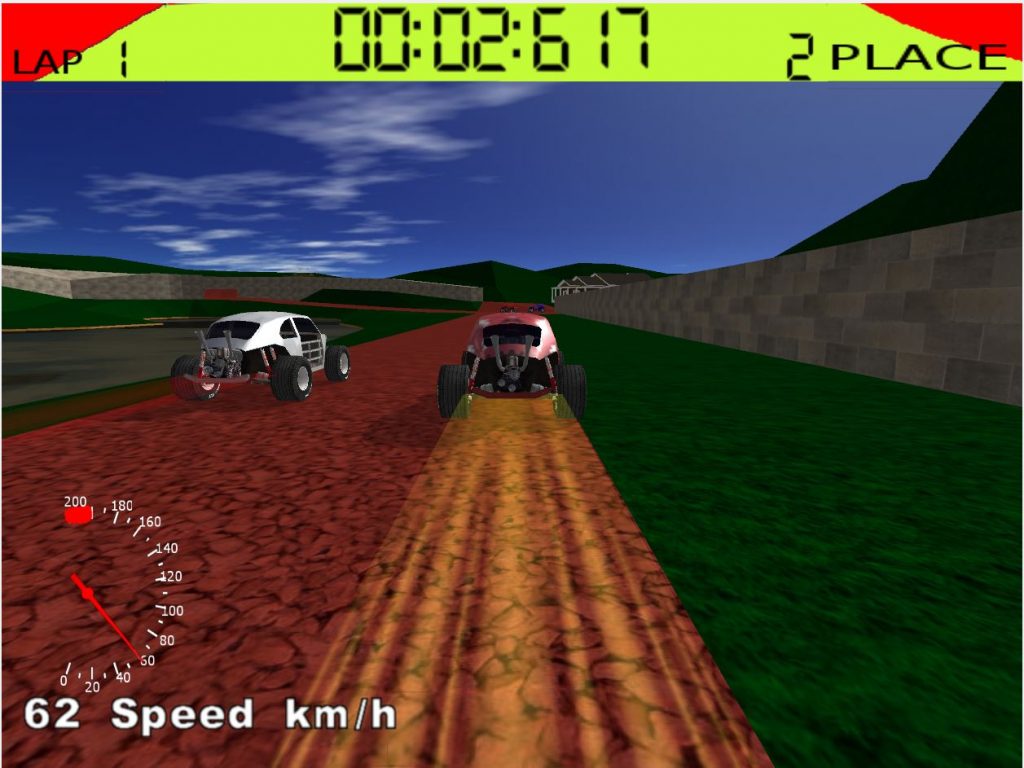
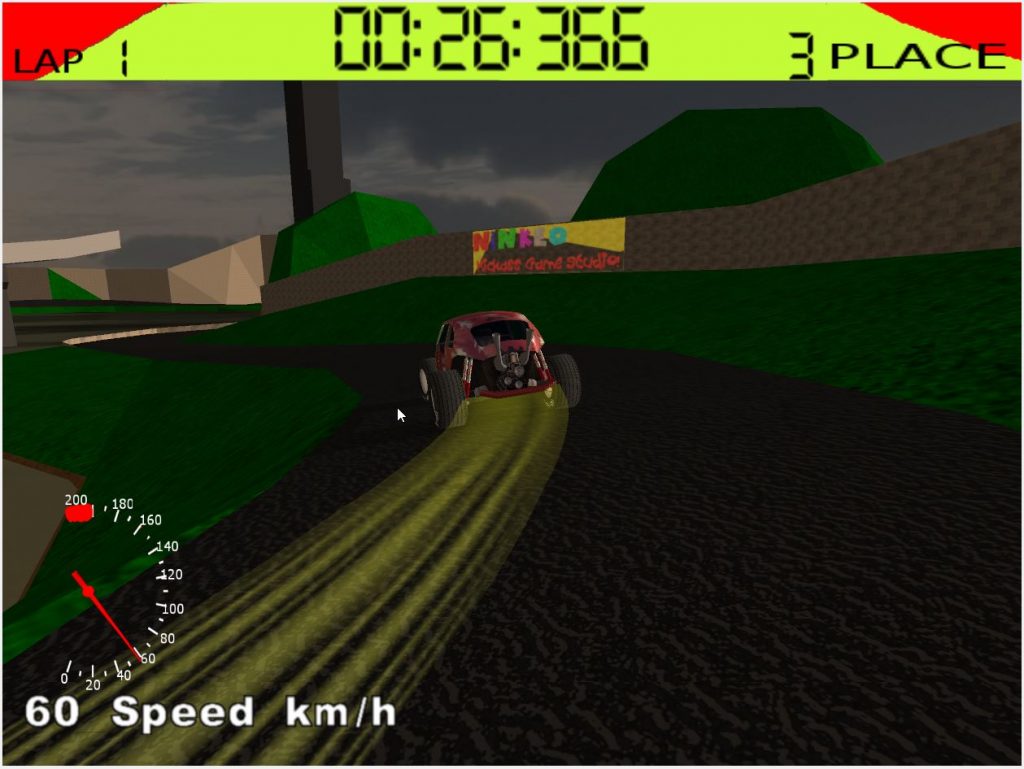
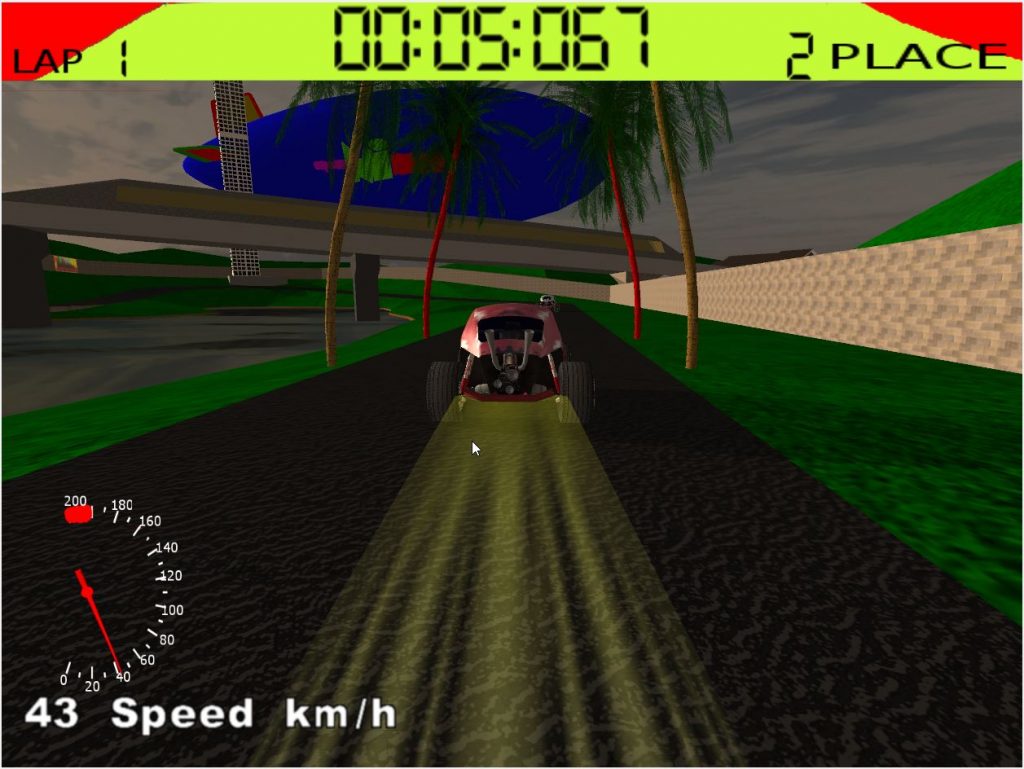
Alpha and Indev builds
The first time Ninkeo Kart in of itself actually appeared, was after we were asked to work on a semester long project for my Multimedia class at school. This had to be done with a mate, so I asked one of my classmates who enjoyed the first preview release, and also the previous “Mad Highway” games to help plan a track and kart setup.
At the time, Minecraft had just launched, so when we did our planning stages, we used the original dev milestones from there. Ninkeo Kart used the “Indev” style milestones, with each release marking a different build. These later changed to “Alpha” builds, which marked the last versions of the game using the original Ultimate Buggy Racing code.The aim of the Indev builds were to create our own tracks, whether they were based upon a map from the Sketchup 3D warehouse, or design from scratch. Due to time constraints, for most of the Indev and Alpha builds, I still had kept the stock 3D Rad buggy cars, which made things easier as we didn’t need to worry about tuning each vehicle independently.
Indev 1
Indev 1 featured the biggest changes overall from the Ultimate Buggy Racing game. The ripoff racetrack was still present, however was renamed from “Andro’s Raceway” to “Blackwater Raceway”, with the layout significantly changed from the original version. Joining this, was three new raceways, “Downey Forest”, “HairPin City”, and “Windy Hill”. The buggy was no longer the only vehicle in the game, as two new cars are also selectable, being the “Range Rover” and the “Radcar 145”. Both of these cars were only in the game during this phase, and were later removed or replaced with more appropiate options. The in-game UI was totally overhauled, with more precise shapes and better contrast in terms of the text and other UI elements. This build featured a title screen, which was temporarily removed from Indev 2, and made a reappearance in Indev 3.
Indev 2
Indev 2 was mostly a bug-fix release, however some things were patched from Indev 1. This release marked the first time the classic ninkeoKART styling would appear, as indicated by the new loading screens. The “Range Rover” was significantly overhauled, and while not shown in the UI, was renamed to be the “Safari Rida”. This is assumed to be in relation to the use of the “Range Rover” name and styling. Some tracks also had invisible guide walls added, presumably to prevent cheating the race. Apart from this, changes look to have been relatively minor from Indev 1, with the notable removal of the title screen.
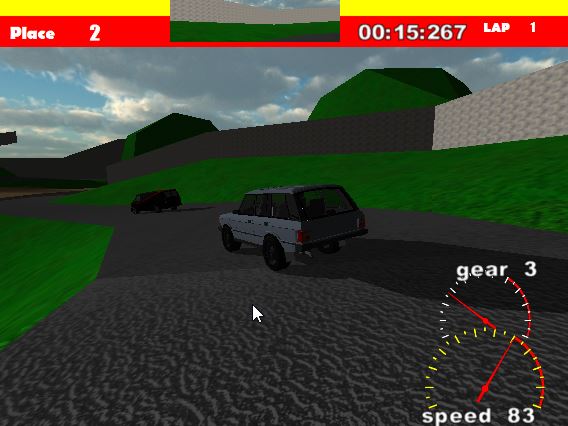
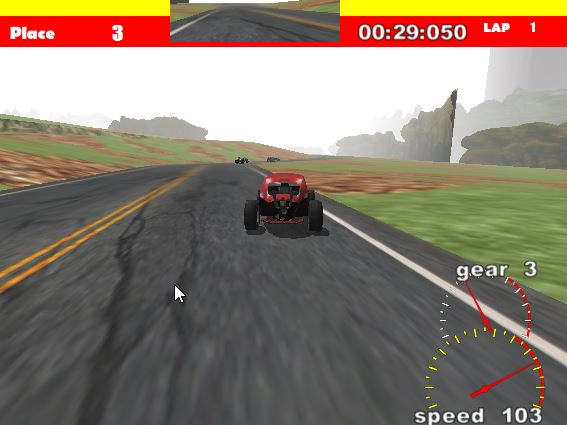
Indev 3
Indev 3 by far had the most changes in terms of UI and design elements. All temporary branding had been removed, showing off the then-new logo. The in-game title screen had been returned and in a new style, showing off all the cars in their 3D form. The menu had also been totally redesigned, with the options “ninkeoKART GP”, “Forest Racing Classic”, and “More choice” now appearing as clickable buttons. The in-game race control menu had also been redesigned with simple buttons designating their function. Some bugs had also been fixed, but it appears most things still remained the same, such as the choice of tracks, and also the amount of vehicles that were present.
Alpha Preview 1
The first of two builds in the Alpha stage, this build further makes changes to the UI elements. The title screen remains mostly unchanged, with the exception of a non functional “Multiplayer” button now replacing the “Forest Racing Clasic” button. The “more choice” button now lists tracks by their respective ninkeoKART GP groups, with each now being in three different cups. However, only the first cup is functional for most. This build also marks the first time the buggy has been altered slightly, with the colours now red and blue, instead of the default red camoflauged models. The “Safari Rida” is now mentioned in name, as well as the “Pickup” now being playable for the first time. Track changes include the removal of fog from Downey Forest, a total redesign of HairPin City, and Windy Hill also having its foggy appearance removed. This also marked the introduction of 4 additional tracks that are normally inaccessible, those being “Rezway”, “Desert Rat Race”, “Training Oval” and “Block Road”. These tracks all become accessible in Preview 2. This build also marks the first with the “Slimline UI”, with all of the elements being located on the bottom center of the screen.
Alpha Preview 2
This build was again mostly a bug-fix release, with some minor adjustments to the UI elements, including the fixing of the “Multiplayer” button on the title screen appearing before the Spacebar is pressed. Only two “cups” are present in the “Freeplay” menu vs the 3 of Preview 1, however both function, making the previously inaccesible tracks playable. “Training Oval” and “Block Road” are both very incomplete, as the AI pathing had not yet been programmed, and start off before the countdown finishes. This also marked the final build in the Indev and Alpha build series, and also the last to have links to the original game.
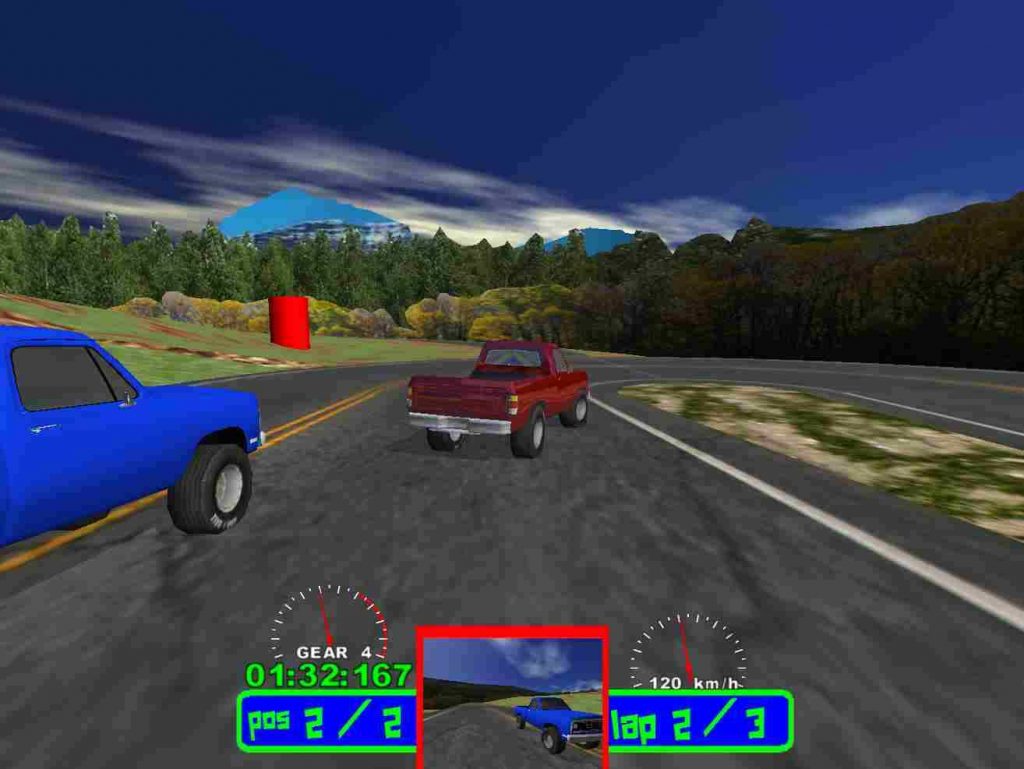
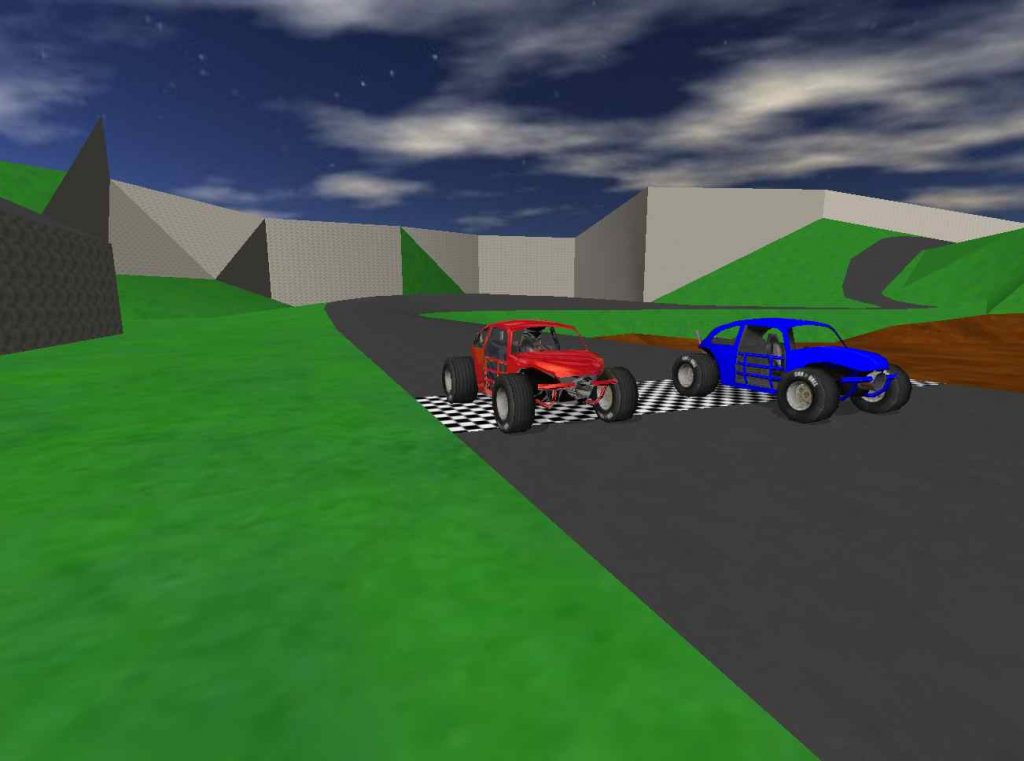
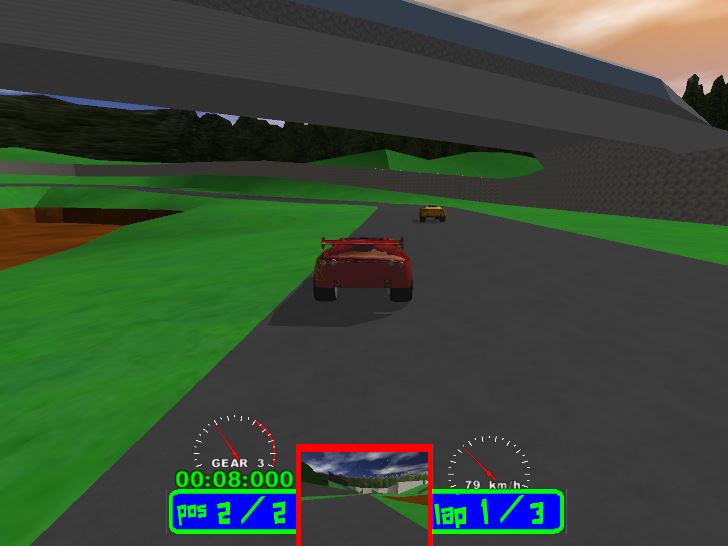
“Crimson” Era
The project “Crimson” era marked a total rebuild of Ninkeo Kart from scratch, throwing all previous code. This also marked the start of the use of more custom cars and tracks for the game, with the first build of the Crimson version featuring a new raceway, titled “Flying Cartwheel Raceway”. This also introduced the “Oldman Racer” and the “Skiddi” carts to the game. Working multiplayer is also included right out of the gate.
Build 0.0
This was an internal, test release that was never released to the public. It only had one working map, a very early version of Flying Cartwheel Raceway, and only has the “Oldman” cart available. No title screen or menu system was yet built, nor was multiplayer.
Build 0.1
The first publically available Crimson build, this introduced multiplayer and the Skiddi cart to the game. Downey Forest was renamed to “Hardwood Valley”, and was only available with the Skiddi cart. The in-game UI was modified again, with the majority of elements moved to the lower left corner of the screen. Unlike the previous Indev builds, the in-game race UI is almost identical to the final game, bar a few minor changes. However, the rest of the game sees significant changes over the course of development. This was also the first version of the game to have a full pause function when entering and exiting the ingame race menu.
Build 0.2
0.2 was where the majority of the groundwork for Ninkeo Kart would be laid. The title screen would be reintroduced in this build, with a main menu screen being fully working, representative of the implemented features in-game. The Freeplay menu now features a detailed kart selection screen, in which each kart now has different handling stats depending on their physical attributes. This also marked the introduction of the newly redesigned Buggy vehicle, sharing nothing in common with the original from the Indev era. As well as the new vehicle, this build also marked the introduction of two new tracks, Snowy Hill, and Breezy Forest. Snowy Hill is a long track where you climb up a mountain and then take a long drive down the opposite side. Breezy Forest is actually a heavily modified version of the old Windy Hill track from Indev, but now features much more foliage and a modified track layout. Vehicle handling for each returning vehicle was tweaked slightly compared to build 0.1.
Build 0.3
This build, for all intends and purposes, may as well be a 0.21 release. It appears to still identifies itself as 0.2, both in the loading screens and general UI. However, the original Freeplay mode that was present in previous builds has been removed, only the GP option is available. This was intended to be moreso a test of the Ninkeo Kart GP, hence the removal of the options.
Build 0.41
Build 0.41 marks the final stages of development for the Crimson era Ninkeo Kart. For the first time, the custom launcher makes an appearance, with arguably too much detail for every setting. The title screen features the mode selection screen after pressing the Enter key as prompted, instead of loading a seperate room to select things from. This build also sees the introduction of the final three raceways for the game, “Green Plains”, “Rezway” (a previously unused raceway from the Indev era), and “Space Highway”. In the Freeplay mode, the “Buggy” vehicle is locked until the completion of the Ninkeo Kart GP, due to its speed and handling style. This build is also the first to block use of the “Esc” key to immediately exit the game, rather it promotes use of the in-game race menu for exiting back to the OS, if running in fullscreen mode.
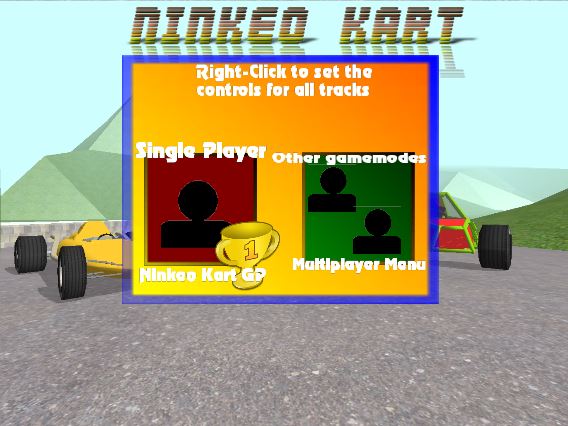
Build 0.40 was pulled after a bug was discovered in the title screen, where the game would crash to the desktop instead of going to any of the other menus. This was rectified in 0.41, and such 0.40 is not available for download.
Build 0.5 Beta
Prior to this build, all releases were designated with the “Alpha” branding, implying that the game was still heavily a work-in-progress title. However, Build 0.5 seeks to tie up any bugs and/or other loose ends that may have appeared during development. The final version of the title screen has now been added to the game, with the previous track fly-around style now removed in favour of a static screen, once again showing all available vehicles in the game. This build also marks the appearance of the “mod interface” button, which for all intents and purposes, is a largely useless feature. It also is the first to have locked the Multiplayer menu behind completing the Ninkeo Kart GP, as well as access to both “Skiddi” and “Buggy” vehicles. The menu interface has been changed significantly again, with a more logical layout in most parts of the game. The GP saw the biggest overhaul, with a number on each vehicle signifying the order that each GP goes in. Many of the in-game bugs have been fixed at this point, but a few remained through to the final build of the game.
Ninkeo Kart v1.05
This was the final public release of the game. In all intents and purposes, this is declared the feature complete version of the game. While aesthetically the same as the beta builds, heavy optimisation took place in terms of rendering quality, and model complexity of the tracks and vehicles. Most bugs reported from the beta build had been fixed, however a few still remain. Along with this build, the official modpack SDK was created, but not released due to licensing issues regarding the 3D Rad game engine.
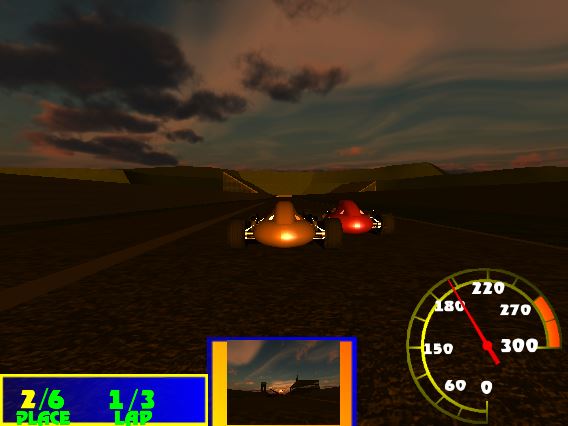
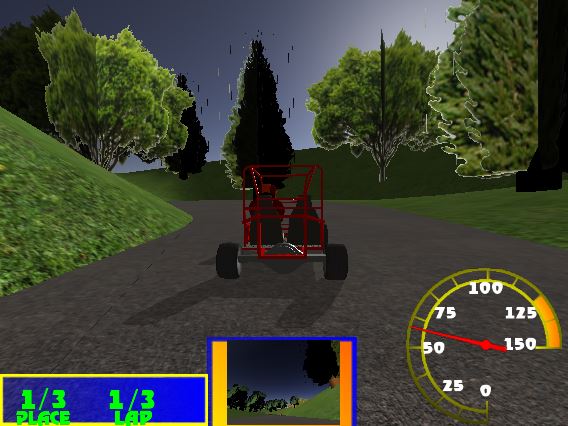
Ninkeo Kart 2
While never finished, there was a sequel planned for Ninkeo Kart. At this point, I was no longer interested in making a long game, rather a tech demo, flash game-like creation due to the lack of time as I was in my final years of school. What I did manage to create, ranged from OK at best, to mediocre.
Ninkeo Kart 2.00
A simple tech demo based on the Crimson codebase demonstrating the new pause menu, and also experimentation with vehicle handling. This one only featured a single track, but however had video options to choose from. The UI was also very “experimental” (aka total shit) and was a previously unused asset from the old Indev versions. This was never released to the public as it was later scrapped in favour of a total rewrite from scratch.
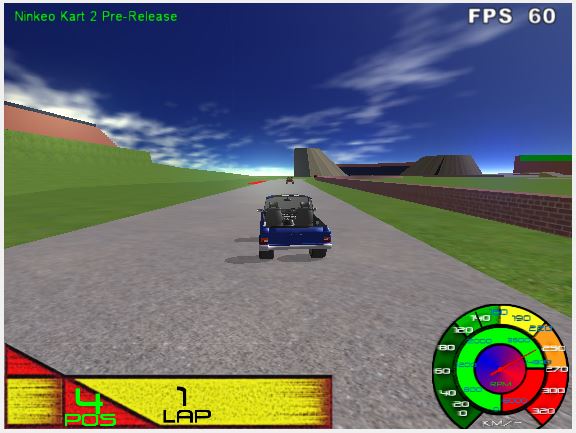
Ninkeo Kart 2 0.10
Based upon what would become the final codebase for the game, this is a new total rewrite from scratch game. Featuring a new-ingame UI that’s much simpler to navigate, karts and tracks are laid out in a chronological order. This introduced the “Speed Master” and “Mini Skiddi”, and also a totally redesigned “Skiddi”. The “Buggy” design was reverted back to the Indev-like design, mostly due to aesthetics reasons, but also due to model complexity issues. This is the only release in which all 4 karts are working.
This release bought back 3 of the 4 classic Indev era tracks, with “Cartwheel Raceway” returning from the NK1 branch. The UI in this version was also an experimentation, and was also changed in the next build also. Being that this version was a total rewrite, many bugs from the NK1 release no longer exist, instead ironed out before the production of the game was rushed. Version 0.10 was the final version before the series went on a 4 year hiatus, until the last version was produced.
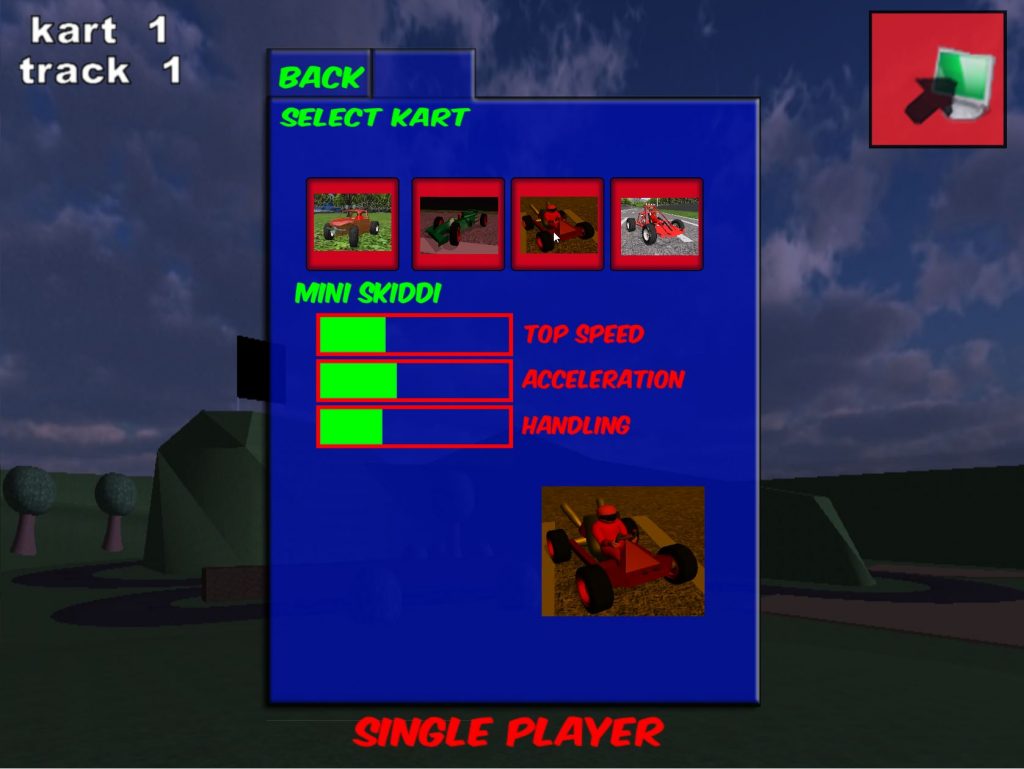
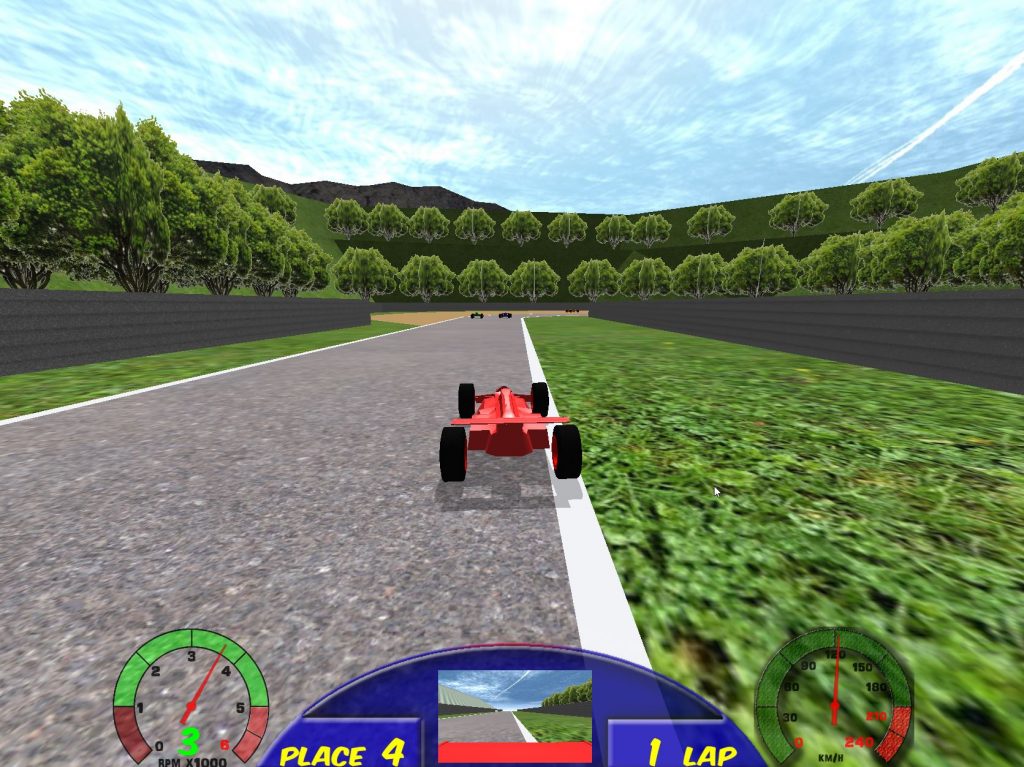
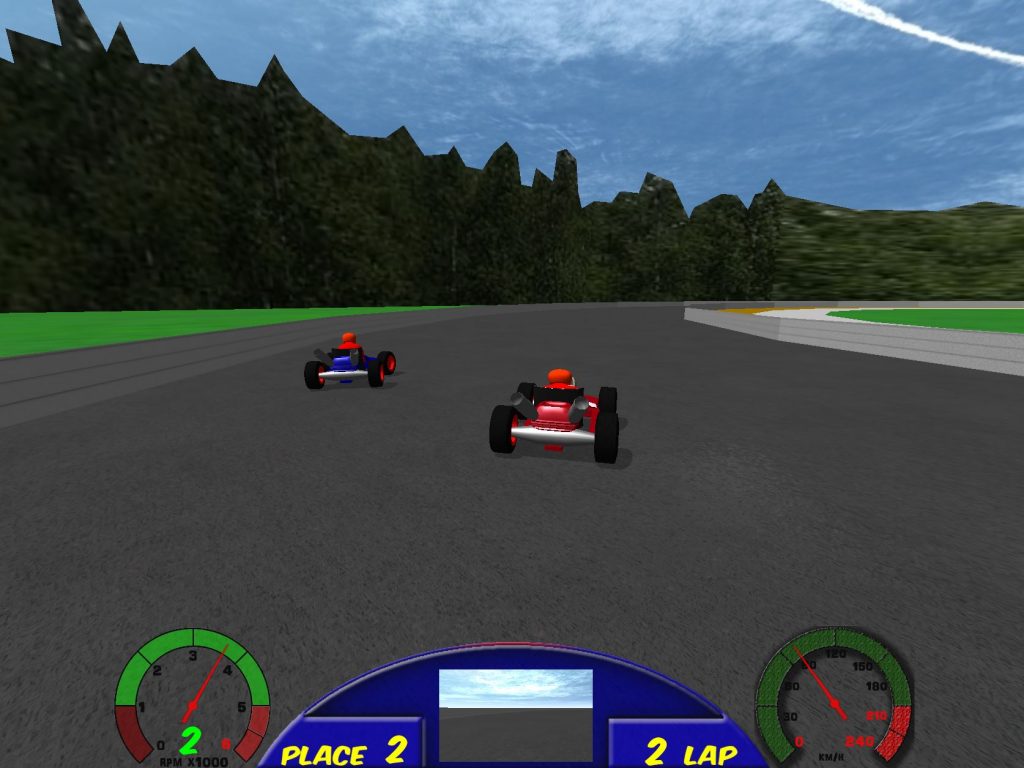
Ninkeo Kart 2 0.20
Ninkeo Kart 2 0.20 was picked up from where the previous release left off. Building upon the core of 0.10, this release forgoes the in-game UI almost completely, rather relegating this to a fancy launcher external to the game. The menu was easy and simple to navigate, gone was the complex web of broken menu items, and incorrect items. This simply loaded HTML files from within the data directory, and presented detailed information about each vehicle and track. Game controls, graphics and sound settings is also visible here, and can be adjusted as desired.
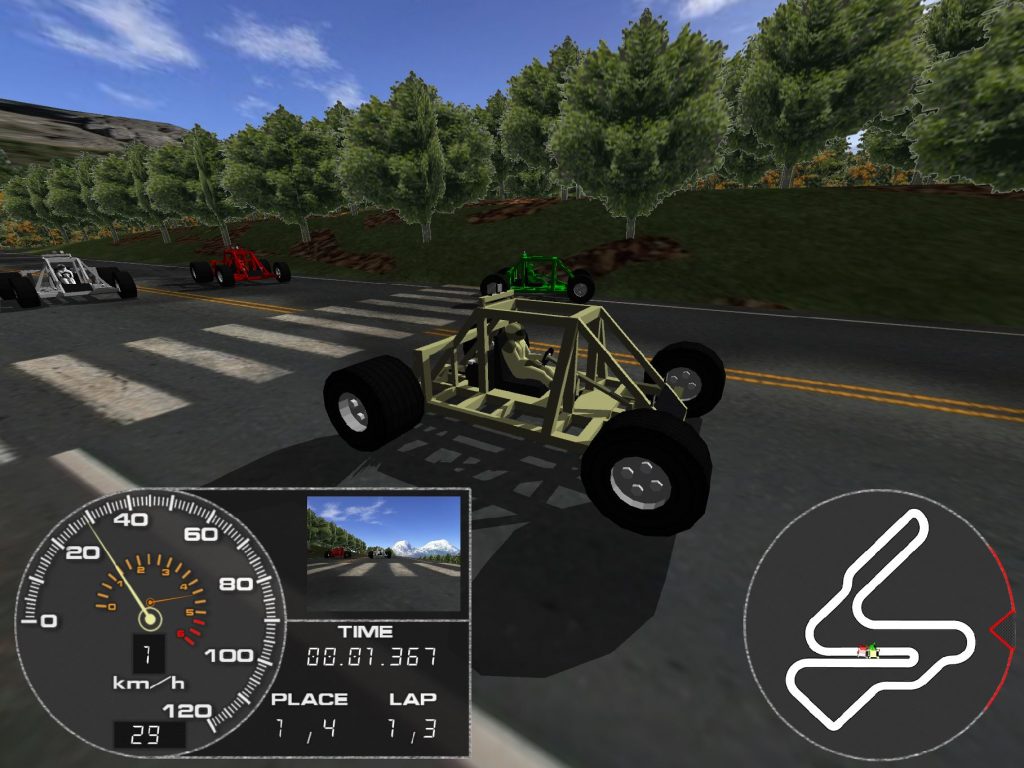
The game itself has also seen a major improvement. Since the overhead of the UI no longer exists, the vehicle handling has been again totally overhauled. While only the Skiddi (called the “Fourbie” in this build) is available in this build, it has been fleshed out to a great extreme. The physics are no longer twitchy and undriveable, and is more realistic. Driving off the track significantly slows down the kart, as to discourage cheating. This version also brings significantly overhauled tracks. Gone are the barren layouts of the old designs, replaced with lush landscapes with plenty of scenery. For the first time in Ninkeo Kart, the tracks are also now fully lightmapped, showing the natural course of shadows and light, significantly improving the overall look and feel of the game. 8 tracks exist in this release, of which only 3 share any resemblence to their previous incarnations. The rest are all entirely new to the game, and all of these new tracks were totally designed by me.
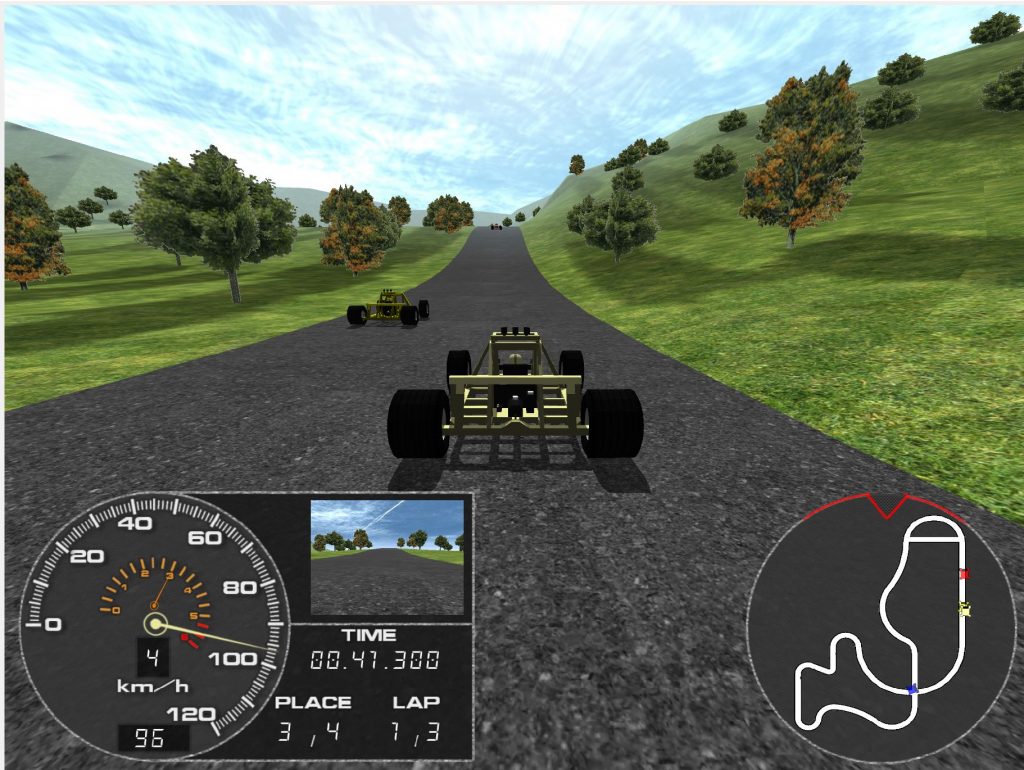
This version of Ninkeo Kart was the only one to have a fully featured launcher app, removing the in-game menus.

Downloads
All of the aforementioned versions of Ninkeo Kart are available for your download and enjoyment. Check out the list below for the files. Each Release is categorised into its own section as per above.
NOTE: The following downloads require the DirectX 9.0C Runtime and Visual C++ 2005 Runtime to be functional. For additional performance, having an NVIDIA PhysX capable graphics card is suggested, but not at all required.
Because of Microsoft’s licensing and distribution limitations, I CANNOT distribute these with the game itself. You will need to source these runtimes from an alternative source. nkn58.xyz will not be responsible for any incidents that may occur from users sourcing their own runtimes from third-party sources.